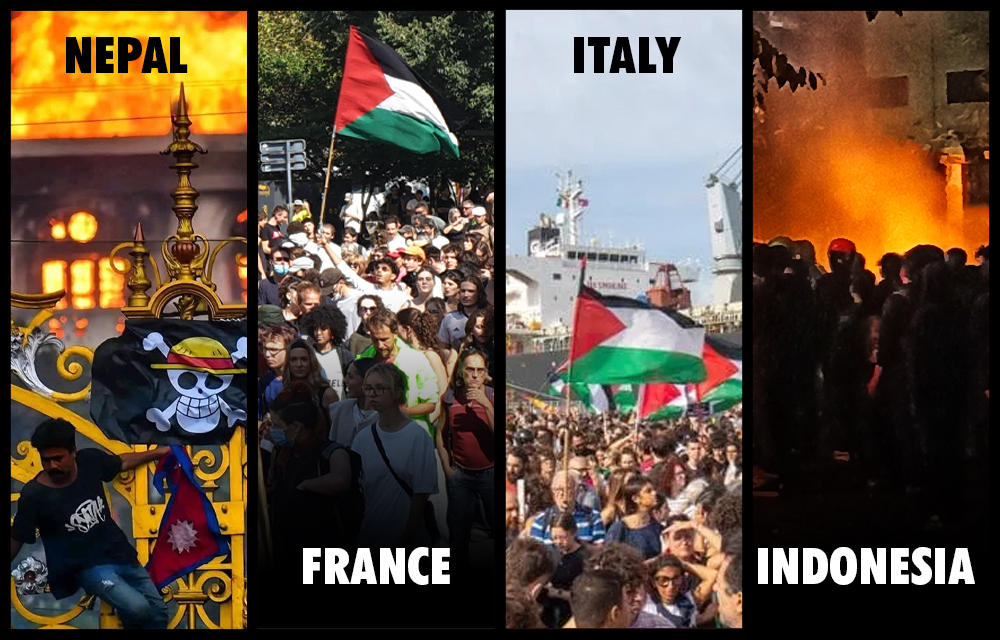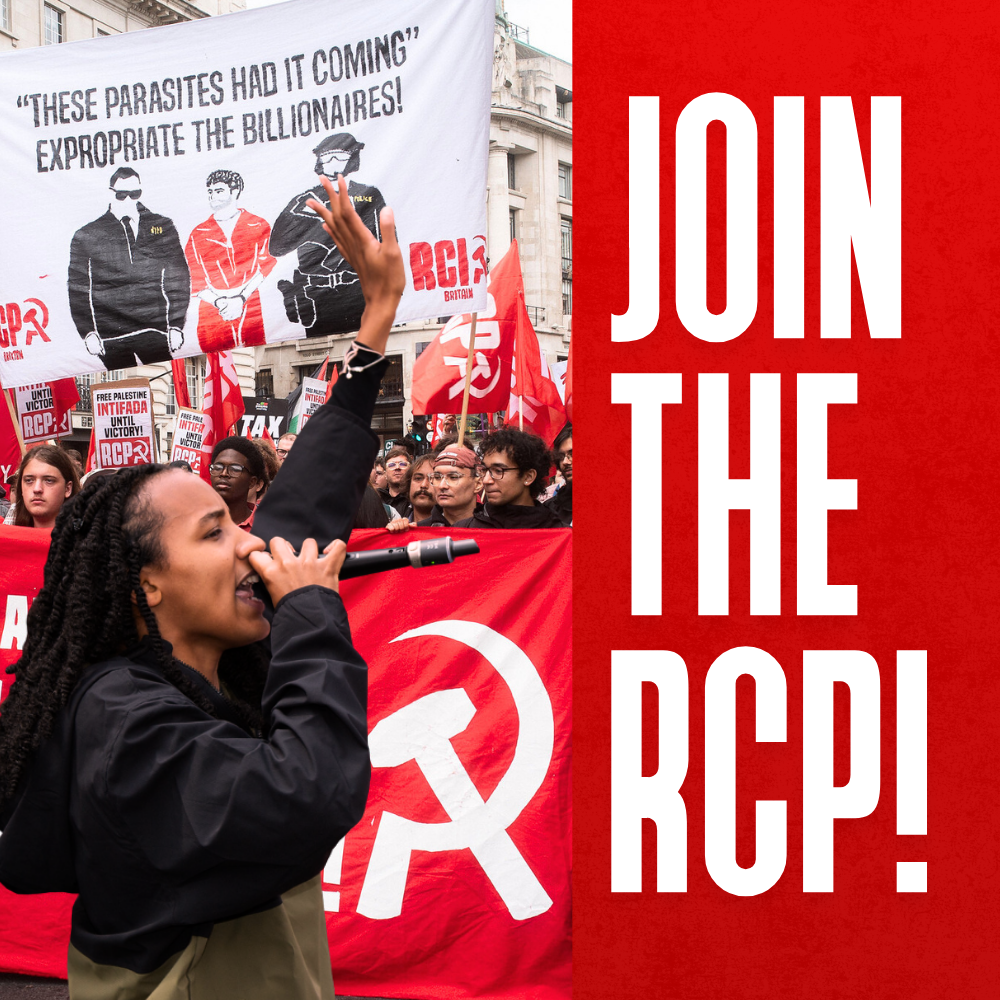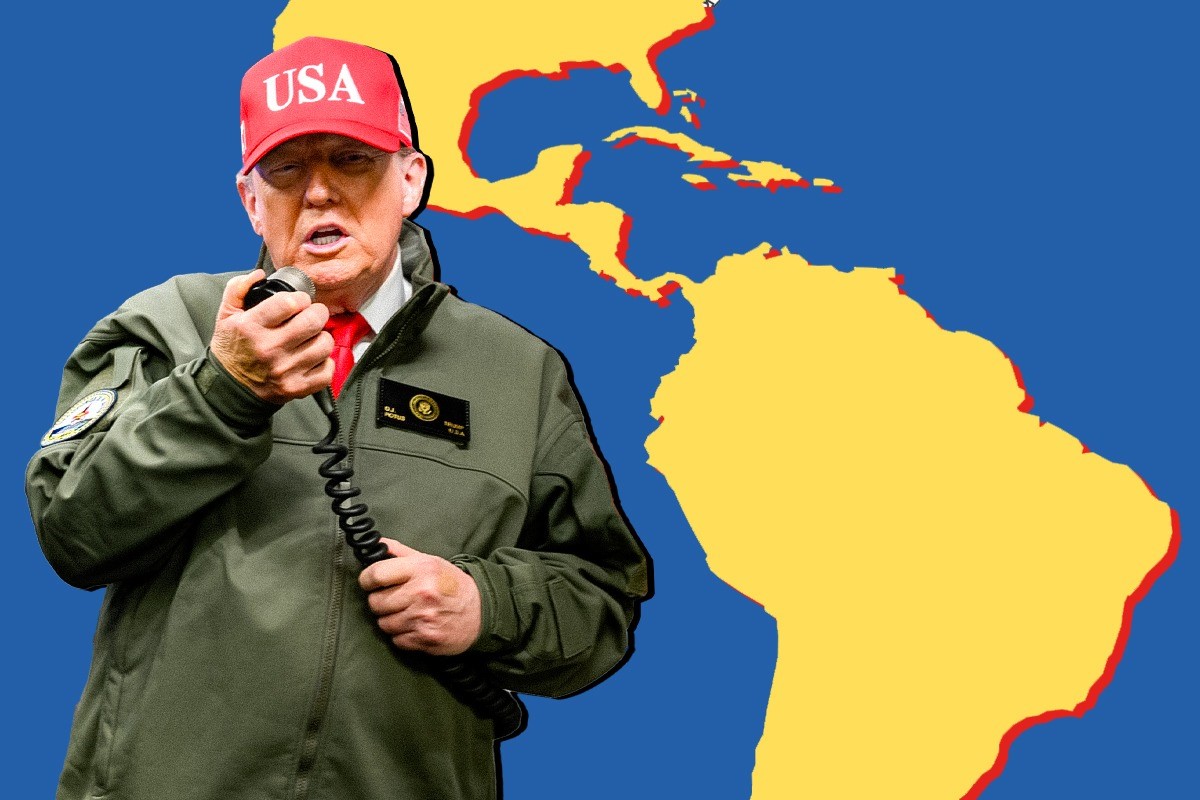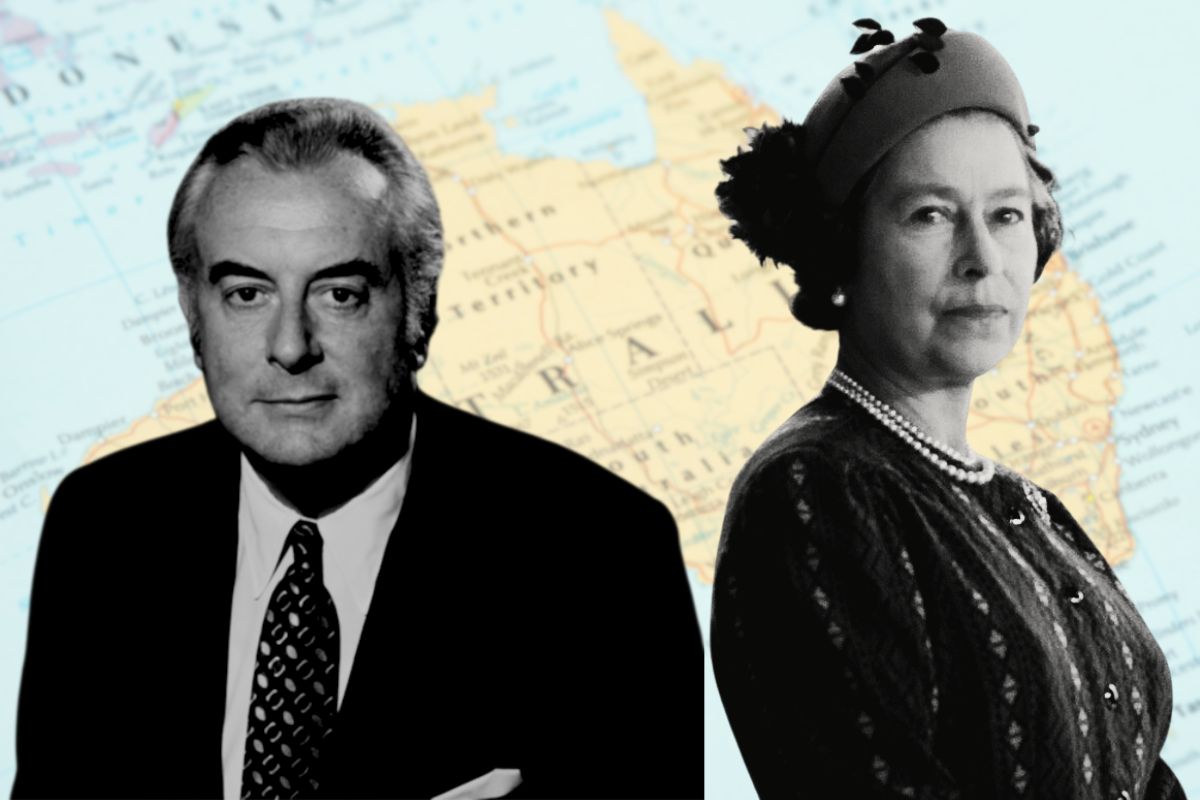The general strike against the genocide in Gaza on 22 September represented a huge outburst of mass anger which has profound implications beyond the borders of Italy. The idea that mass direct action is needed to stop Israel’s murderous assault on the Palestinians now dominates.
At the same time, the Italian mass protest can also be seen as part of a ‘Red September’ of mass uprisings, revolutions and insurrections across the world.
The Italian comrades of the Partito Comunista Rivoluzionario (PCR) have already drawn a balance sheet of the 22 September mass movement, but it is worth going over the main facts again here.
Under enormous pressure from the rank and file, the leaders of the main trade union confederation, the CGIL, had called a 2 hour strike in every shift on Friday 19 September. The idea was to let off steam with a mainly symbolic action. The national leadership did nothing to make the limited strike a success. In fact, by leaving the final decision to workplace, local and regional structures, they were probably banking on it being a flop – so that they could then say, “see, we have called for strike, but the workers have not participated”. Despite this, tens of thousands marched across the country.
A small militant union, USB, had put out a call for a 24 hour strike for Monday 22 September. The actual strike had an uneven following, affecting schools, public transport and the health service. Of course, it involved not only members of the USB, but thousands of workers who are members of the CGIL – despite the failures of their leadership – and many who are not in any union.
But hundreds of thousands took to the streets during the day in over 80 cities and towns across the country in an impressive show of solidarity with Palestine. The USB is too small to have actually organised the movement we saw on Monday. Of course, the USB should be congratulated for having taken the initiative and for having made the legal call for strike. This was one of those times when merely naming the date provided a rallying point for an upswell of indignation, which had been accumulating and now found a channel of expression.
Livorno, Italy: dockers and local residents organise a permanent blockade of the harbour to prevent the docking of the SLNC Severn ship suspected of carrying US weapons to the Camp Darby base which activists say maybe used in Gaza. pic.twitter.com/TDDQRRgraC
— Jorge Martin ☭ (@marxistJorge) September 25, 2025
A hundred thousand came out in Rome, 50,000 came out undeterred by torrential rain in Milan, tens of thousands in Turin, Bologna, Genoa, and a long list of cities and towns, big and small.
‘Block everything’
These were not just your usual demonstrations, marching from point A to point B followed by lukewarm, uninspiring speeches from the stage. The slogan was “we block everything” (Blocchiamo tutto) – a direct reference to the French strike movement of 10 and 18 September, which has clearly served as an inspiration to millions of Italian workers and youth.
Like in Italy, the movement in France was not organised by the leadership of the CGT, but came from below in a semi-spontaneous way. The leaders of the CGT had to be dragged in, kicking and screaming, and mainly played the role of dampening the mood, limiting the scope of the movement, and generally trying to divert the anger into safe, harmless channels.
In Italy, thousands participated in mass pickets outside railway stations, transport hubs, blockaded harbours and motorways. There have been many mass demonstrations in solidarity with Palestine over the last two years. The masses on the streets in Italy on Monday understood that simply demonstrating is not enough.
In Livorno, the dockers, with the support of the local workers and youth, occupied the harbour and physically prevented the docking of the SLNC Severn, a ship transporting US military material. After three days of occupation, it was confirmed that the ship had been turned away and would not return.
At the end of the demonstration in Rome, thousands then marched on to blockade the main ring roads around the capital. They were met with solidarity and support from the drivers. Claudio Belloti, a leading member of the PCR in Rome described the mood in this way:
“Electric mood in Rome, huge crowd in the demo and incredible show of solidarity from bystanders. Even drivers blocked by the demo honked, saluted with clenched fists, some even waved the Palestinian flag! The dam has broken and a river of mass action is now flowing.”
Another significant feature of the Italian movement on Monday was the participation of the youth, walking out in organised blocs from high schools and universities. The mood which can be seen in the videos is a very angry one, but also one of determination. This is in tune with the mass movements we have seen in other countries.
The Gaza solidarity flotilla has galvanised an unprecedented mass movement. Tens of thousands came out to bid it farewell in Genoa and Barcelona a couple of weeks ago. On 22 September in Italy the masses had a taste of their own strength.
The movement has issued a warning that on the day Israel attacks the flotilla, workers and youth will bring Italy to a standstill. This is not an idle boast. Monday was the general rehearsal. The leadership of the CGIL, completely overtaken by the mass movement on 22 September, has now decided to join in that call by the USB.
A similar mood has been developing in the Spanish State where 100,000 came out in Madrid to block the last stage of the Vuelta a España cycling race. Protests had already occurred in earlier stages, with protesters disrupting the race in rejection of the participation of an Israeli team, but things came to a head in Madrid on 14 September.
Thousands of riot police had been deployed to make sure the race would finish as organised and there would be a prize ceremony. But how can you police the route of a cycling race which is tens of kilometres long?
Tens of thousands lined up the route, ready to vent their anger. At several points in the centre of Madrid they broke through the protective fencing and used those same fences to block the streets through which cyclists were meant to race. The police attacked them with tear gas and foam projectiles, but the crowd bravely fought back, overwhelming them and forcing the organisers to abandon the race.
A call has been made for a nationwide student walkout on 2 October, as well as a similar warning that the day when Israel attacks the flotilla, the Spanish State will also be paralysed by a mass protest movement. Now, even the leaders of the main trade union confederations, the UGT and CCOO, have called for a day of workplace action for Palestine… on 15 October. A case of too little, too late many say.
A worldwide whirlwind
It is impossible not to see in these events the echo of the mass uprisings in Indonesia and Nepal in the last few weeks, as well as of the mass movement in France mentioned earlier. They, in turn, have served as an inspiration for mass movements, in many cases led by the youth, in East Timor, Philippines and now also in Peru.
In Ecuador, the CONAIE indigenous and peasant organisation has launched a national strike against the lifting of fuel subsidies, against corruption and crime under the government of Noboa. As I write these lines, the youth in Madagascar have taken to the streets to protest water and electricity cut-offs. A general strike has been called in Greece on 1 October and a national day of strike action in France on 2 October. The Serbian mass movement is also continuing after 10 months.
Let’s be clear, we are not just talking about copy-cat movements. No. Each of them has its roots in the actual conditions in each of these countries: the discrediting of the corrupt political elite, a gaping gulf between the rich and the poor, a generation of youth which is offered no future, 15 years of austerity policies which are now followed by yet another attempt to make the workers pay for the crisis of capitalism, etc… These are the conditions which have created an enormously flammable situation worldwide. The point is that, to one degree or another, these conditions now exist in so many different countries around the world!
The fact that the pirate flag of the Strawhat Crew (from the One Piece manga comic), which was used by the protesters in Indonesia earlier this month, is being flown also in Paris, Lima, Manila and Antananarivo, shows that the youth instinctively understands the international character of their movement.
At the same time, it is undeniable that the images of the Nepalese masses burning down the hated sites of power have been a powerful source of inspiration, as were the images of the masses breaking into the presidential palace in Sri Lanka just a few years ago.
The videos, shared instantly on social media, of French workers and youth bringing the country to a standstill, provide a palpable example of the power of the working class to millions who are yearning for change. The idea has caught on: something must be done, something can be done, mass direct action is the way forward.
And the massacre in Gaza has acted as a lighting rod for the accumulated anger at the ruling class, their sickening double standards – a genocide, broadcast live, for nearly two years, with all the western imperialist powers giving Israel full backing.
Also in the last few weeks we have seen huge, unprecedented demonstrations in solidarity with Palestine, in Holland, in Belgium, in Australia.
The situation that has been created is so explosive that it has forced the rulers of Britain, Canada, France and Australia to attempt to ingratiate themselves with public opinion by recognising the Palestinian state – a state which doesn’t have any real existence – while at the same time they continue to arm and fund the Israeli state, which is carrying out the genocide.
In the Spanish State, where the mood of public opinion is even more radical, and the ruling ‘Socialist’ Party is in an unstable coalition and depends on a very fragile parliamentary majority, Pedro Sánchez has even been forced to promise even a complete arms embargo on Israel (though one needs to carefully read the smallprint to see there are caveats).
Italy and Spain send Navy vessels “to aid” the Gaza Flotilla
On the night of 23-24 September, the Gaza Flotilla was attacked by drones and its radio communications were jammed. It is clear to everyone with a thinking mind that this was yet another warning from Israel against any attempt to break the Gaza blockade and deliver humanitarian aid.
Ships of the Global Sumud Flotilla came under a drone attack at dawn in the Mediterranean Sea while sailing towards Gaza to break the Israeli siege. The mass movement in Spain and Italy has committed to mass walkout and port blockades if the Flotilla is attacked. pic.twitter.com/wbJKpR7b27
— Jorge Martin ☭ (@marxistJorge) September 24, 2025
After the huge mass mobilisation and strikes on Monday in Italy, this has now become a central political point in that country. Such is the mood of public opinion that the Italian Foreign Minister, who was in Estonia at the time of the attack, was forced to issue a public statement condemning it and to send a Navy frigate in the direction of the Flotilla, a fact reported to the Israelis. This is a major escalation and an unprecedented step. It is not one which the right-wing government of Italy has taken willingly, but rather one which has been forced onto it by the enormous pressure of the mass movement.
Let’s be clear. The frigate’s remit is not to defend the flotilla from Israeli attack, but “to provide assistance to Italian citizens which are part of it in case that becomes necessary”. Still, it is a very strong gesture. Meanwhile, Italian Prime Minister Meloni rails against the flotilla, calls them irresponsible and is demanding they hand over aid… to the IDF!
The Italian decision was followed a few hours later by a statement by Spanish President Pedro Sánchez, who is also under strong pressure from public opinion to take a similar measure. He has ordered a Spanish navy ship to sail towards the flotilla tomorrow.
Again, another strong gesture. Again, with clear caveats: “The mission would not be to confront a possible Israeli aggression against the Flotilla, but to provide it with assistance in case of need. The ship would only operate in International waters.”
The brutal genocide being carried out by Israel in Gaza (and the West Bank) has led to a sharp shift in consciousness and a mass radicalisation in several western countries. Their leaders feel under increasing pressure. Italy and Spain are particularly affected, as the flotilla is largely drawn from these two countries.
The question of Gaza – the callous double standards of the western imperialist governments which denounce Russia in Ukraine and demand more weapons and more military spending for that conflict, while at the same time supporting the bloody Israeli onslaught on Gaza – has acted like a lightning rod for political radicalisation against the system from the left.
This is an insoluble problem for the governments of Italy and Spain and many others. The more they make gestures towards the movement (such as finally, after two years, calling what Israel is doing in Gaza a ‘genocide’), the more the masses demand action – not words. The more cosmetic concessions are made to the movement, the more the masses feel that only direct action will work.
They are not wrong. The question should be posed clearly. Only a workers’ boycott can help cut off the Israeli war machine from its supply lines. Dockers, workers in the defence industry, transport workers in general – they have the power to stop supplies, ammunition and fuel going to the IDF. Solidarity with Palestine must be linked to the need to overthrow the warmongers at home. The mass movement should trust only its own forces.
Turbulent times
One thing is clear. We live in an extremely turbulent period. Contrary to those who weep about a turn to the right in society and the danger of fascism coming to power (or already being in power!), what we see is a process of enormous political polarisation. It is driven by the crisis of capitalism, which in turn has led to a collapse of the legitimacy of the established institutions of bourgeois democracy.
That has expressed itself, partially, in the rise of right-wing, reactionary demagogues, which have taken advantage of that mood of anger. But it is also leading, increasingly, to instances of the direct eruption of the masses on the scene of history attempting to take matters into their own hands.
Indonesia, Nepal, Timor Leste, Peru, Philippines, France, Serbia, Madrid, Italy… What a month, and September is not even over yet! pic.twitter.com/W6AlMBHVKK
— Jorge Martin ☭ (@marxistJorge) September 22, 2025
Of course, we have been here before. Since the 2008 capitalist crisis, there have been several such waves of mass movements and insurrections. In 2011, we saw the outbreak of the Arab Spring, with the revolutionary overthrow of the hated reactionary pro-imperialists regimes of Mubarak and Ben Alí in Egypt and Tunisia, as well as the occupation of the squares by the Indignados (in Spain), the Syntagma square movement (in Greece), and the Occupy movement (in the US).
In 2015 we witnessed the massive battles against capitalist austerity in Greece, as well as the rise of Podemos, Melenchon, Sanders and Corbyn. Then, in 2019-20, we had uprisings in Ecuador and Chile, the Sudanese revolution, the national strike in Colombia and the Black Lives Matter upsurge in the United States.
Time and again, the mass of workers and youth have given their all, in most cases without any leadership and in some cases against the established leadership, to take matters into their own hands and fundamentally transform their conditions. More cannot be asked of them.
The reason why all of these movements have ended up in a cul-de-sac is the lack of a revolutionary leadership strong enough and possessing the necessary roots to lead them to victory, which can only be achieved through the abolition of the capitalist system and the workers coming to power.
A new period of eruption of the class struggle has broken out. What a time to be alive! What a few weeks these have been! (And September is not over yet).
[Originally posted on Marxist.com on 25th September 2025]






